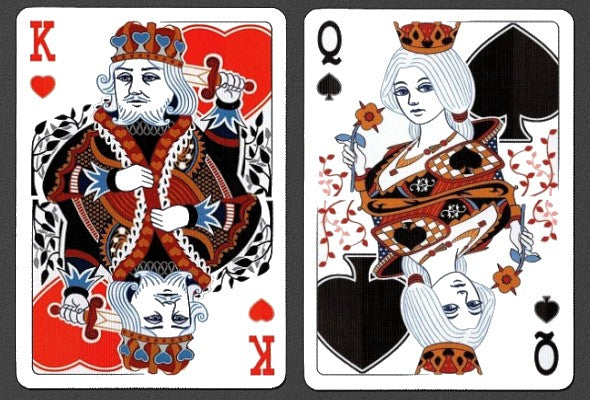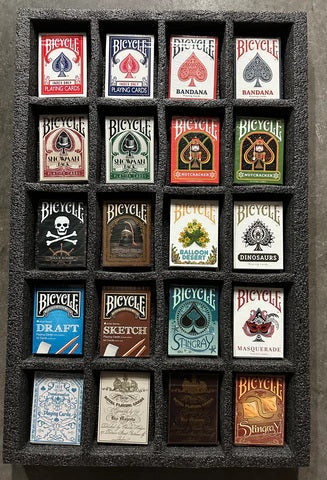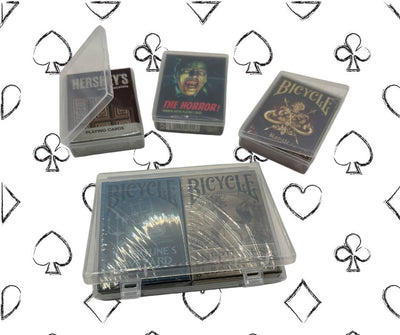Who is Artur Rajch?
Most of my readers have an interest in playing cards. Some of you even stay up-to-date with all the latest custom playing card decks hitting the market. So perhaps you even have a good idea what some of the biggest names in the business are. Popular brands like Virtuoso, Fontaine, and Organic Playing Cards. And popular designers like Alex Chin, Jackson Robinson, Stockholm17, and Giovanni Meroni.So it may be somewhat of a surprise to come across the name Artur Rajch, who is the subject of this interview. You might be thinking to yourself: Who is this guy, and have I even heard of him before? While you may not immediately recognize his name, I suspect that many of my readers will recognize his work. In fact, you may even own one or more of the custom decks of playing cards he has designed. That's because Artur tends to produce most of his playing cards under the PlayingCardDecks label, and his own name falls more to the background. In other words, Artur is a playing card designer who is better known for his work than for his name.
I first came across Artur's work when I picked up the first deck of custom deck that he produced: The Guard. I was immediately drawn to the ornate designs of the court cards, which had a fresh and imaginative look to them, instantly setting them apart from the many usual variations we see of traditional court cards. After this success, Artur continued to fine-tune his style, and so came about a popular series of custom playing cards that is still ongoing, the majority of which feature insects. It's a series that I personally refer to as the "Tiny Critter" series, and it is quite likely that you've come across one or more of them - and you may even have some in your own personal collection if you're a collector: Bicycle Ladybug, Bicycle Beekeeper, Bicycle Dragonfly, Bicycle Ant, Bicycle Caterpillar, and the forthcoming Bicycle Butterfly. All of these first appeared in PCD's Pip Box Club, which gave members the chance to enjoy these ahead of the official release.
There's no doubt that Artur has a distinctive and instantly recognizable style, and his current series of tiny critter themed playing cards is attracting the attention of a growing number of collectors. I figured that it was time to find out more about him, and give some more attention and positive press to his work. So I approached him and asked if he'd be willing to answer some questions about his work as a playing card designer. Fortunately for us all, he agreed to do this interview, in order to share some of his own experiences as a playing card designer, and to offer some of his own insights and thoughts about playing cards.
The Interview
For those who don't know anything about you, what can you tell us about yourself and your background?Well, my name is Artur Rajch, and I live in Poland in a beautifully situated area in the Holy Cross Mountains. Next year I will start my fifth decade. I am a professional illustrator - a freelancer. So on a daily basis I sit at home in front of the computer and create illustrations and graphics.
My interests are very wide, but music is certainly the most faithful companion at work. It gives inspiration, soothes nerves and allows you to focus on work. This is very important especially for a freelancer who works from home. In my spare time I ride a bike, and I also love to travel. So it is just an ordinary life.
When did you start designing playing cards, and what got you started
My card making experience is relatively short. I have been working as an illustrator for 22 years, but I have been dealing with playing cards for only 4 years. Previously, I mainly illustrated books and puzzles for children. I have cooperated among others with LEGO, and I have also created fantasy and sci-fi works.
My first contact with working with playing cards was through an advertisement on a popular freelance portal. Working on children's illustrations is tiring in the long run and I think I wanted to try my hand at a new aesthetic. That's why I replied to the advertisement, and today I know that it was a good decision.
What was your very first deck, and what do you like/dislike about it
My first deck is The Guard. Generally speaking, I have such a rule that I never hand over for approval a project that I don't like. I only offer my clients the variants that I like. That way it rarely happens that later I have a problem with the final product. It seems to me that cooperation should be based on mutual trust. This is important because the client, in a sense, entrusts you with the success of the entire project. If you know that someone trusts you, then you give more of yourself.
How many decks have you designed so far, and which of these have been your most popular and successful designs?
I've never counted, but it's a good reason to finally do it. So I have 12 completed decks of cards, but there are also many other projects that I've been involved in, e.g. just making the back of the cards or the tuck box. There are several new projects still on my desk waiting for their turn.
Unfortunately, I don't know which decks were successful and which were not, because it is the client who can view the quantity of the product sold. But it seems to me that Ladybug deck and the Beehive deck received quite a positive reception.
How do you come up with an idea for a deck design?
It seems to me that I have the ability to easily visualize someone's ideas. In fact, when I read an e-mail from a client, I can already see (with the eyes of my imagination) what it might look like. So this process doesn't take time at all, it just appears in your mind, and then you just have to sit down and do it.
What are some of the things you especially enjoy about designing playing cards?
The coolest moment is when you hold the finished product in your hand and have the satisfaction that you did it right.
But that's not what you asked ... I think the most interesting part is the process of implementing new techniques that you have just learned. There is double satisfaction when it works and you like it.
I also like to adapt the already available patterns to the style of the deck. There are several old Polish card designs that I would like to re-edit.
But there is also the other side of the coin. Unfortunately, after 20 years of work, routine kills the pleasure resulting from the work process itself. The freelance profession has many advantages, but it also has its own rules that must be followed. The main rule is to work quickly but well at the same time. Quick work, because if you work slowly, you will not earn as much as you want. Good work, because if you give the customer some crap, he won't come back to you again.
Which deck in your portfolio of created designs is your favourite, and why?
Coffee Culture is my favorite deck. It is in the style of the 1960s, it concerns the variety of coffee drinking in the world. It will probably be released in the first quarter of 2022.
The client gave me full creative freedom, so I was able to use the full range of design instruments. The 1960s was a baroque of our time, because then everything was beautiful, sublime, and harmonious while maintaining a soft and subtle approach: in architecture, hairstyles, cars, interior design, color combinations, fashion, music etc. I think we've been going backwards in this regard ever since.
You have created a number of decks that are clearly part of a series: e.g. Ladybug, Dragonfly, Ant, Butterfly, and Caterpillar. How did you originally come up with the delightful court cards that we first saw in your Guard deck?
I admit that I don't really know, because the creative process is a unique phenomenon. For some it is easy, for others it is more difficult, and fortunately I belong to the first group.
I have always liked classic cards and the classic way of visualizing them, so my original inspiration was the so-called English Pattern. However, I gave it individual features, but in such a discreet way that they still imitate classic cards. It wasn't really difficult, but I admit that I was very happy to make this deck. Someone once said that simple things are doubly enjoyable.
Do you have more decks planned for this series, and is there anything you can tell us about them?
Above all, the condition for the continuation of this series is whether it will still be popular with customers. The series was invented by Will Roya, and its further fate depends on him. But I can only promise that I will continue to try to keep the series consistent and looking good. And I can add that I am preparing new decks for the series.
A lot of playing card enthusiasts really enjoy this series. Does this series have a name? (e.g. Bug series, or Tiny Critters)
No, the series doesn't have an official name. In my head - it's just "insects" . But I will tell you a secret that the featured character of the deck I have been doing recently is definitely not an insect. And that's why this deck is a bit different from its predecessors. You will see everything in time.
How would you describe the style of your playing card decks?
I work on commission, so the style of the illustrations largely depends on the client and his expectations. I have many styles and basically I can make cards in any style. But I haven't developed my individual style yet, because with commission work there's not much room for that.
As I said before, I like the classic style, but I understand that this does not always fit the idea that the client wants to implement. Recently, I have been making futuristic cards where the colors had to be heavily distorted and the graphics of the court cards required resemblance to real characters. I always try to dissuade the client from the aesthetic intensity on the playing cards and always give 2-3 aesthetic choices. But it is the customer who has the final say in the entire process, because he is responsible for any possible profits.
Are there any particular features or characteristics of your decks that you hope people will notice and appreciate, or help make your decks different from the many others out there?
After a few years of observation, I can say that the community of card collectors is exceptionally tasteful and sophisticated. This is very pleasing, especially to me, because I can make projects for clients who have good taste, that are completely different from illustrations for children. However, clients who aren't experienced with playing cards often have the opinion that it is better when there is something more. That is why I often try to bridle a new client (like a horse in a meadow!), because that approach doesn't work with playing cards.
When it comes to a distinctive feature of my style, my "stamp" is probably a large pip on the right side of the court card, which is an element of the entire design. I think it looks interesting and it's easier to tell the color of the card.
What is your process in designing a deck of playing cards, starting with the concept, all the way to completing the project and having finished decks?
I start each project with the most difficult things, because then the rest of the job is on the other side of the initial hump. The most difficult thing is designing the court cards. They take the longest time, and the customer acceptance process also takes the longest. The box and the back of the card are the most important elements, because they must be consistent. That's why I make them at the end of the process, to make them match well with the faces of the cards.
What has it been like working with Will Roya from PlayingCardDecks, and what involvement does he have in making and producing your decks?
Will Roya is a very good and understanding client. It is surprising that he has not been yelling at me yet for all those mistakes, missing pips, and uneven frames! I have a huge amount of creative freedom and I'm glad that he still has confidence in my taste and skills, since as I mentioned earlier this is very important in the creative process, at least in my case.
What is it about designing a deck of playing cards as a creator that you wish consumers realized more?
This is still somewhat of a mystery to me. My only contact with the consumers of the playing cards that I have made is reading what they say about my decks on forums. I have personally not been involved in the publishing process of playing cards, or I have not really listened to the comments of people interested in buying my cards. I have always made cards for clients and only their opinion was important to me. I am planning to release my own deck, just out of curiosity, to see for myself what it is like. Maybe then I will know more?
How much time does it take to actually design a deck? What aspects of this take the most work and time?
It takes me about a month to complete the entire deck. This of course may take more time. For example, I have been doing my own deck for three months, and I still see things to improve. In that case, however, I do not have to hurry, and I can pamper it in my spare time. Updating an already made deck, by making new backs and a tuck box takes about a week of work. Of course, court cards take the most time, depending on the style, and it can take 2-3 days to make one card.
Do you also collect cards yourself? Is there anything you can share about your personal collection, and what you especially like collecting?
No, I'm not a collector yet. I wrote "yet" on purpose, because I have to say that there is something fascinating about the multitude of aesthetics, the stylistic diversity, and the variety of compositions ... Of course, I have a dozen or so decks, but I would not call it a collection.
I look at playing cards a bit differently than collectors, and more as a design enthusiast in every aspect of it. I collect knowledge of how to make details like an ornament, braid, floral motif; how to match colors; how to create a depth of a plan; and how to make various elements consistent. This is what I get the main satisfaction from when it comes to playing cards.
Playing cards are a very rewarding design field from a technical viewpoint. There is a some base material: only 54 cards, the card back, and the tuck box. From there, subtle visual changes create huge diversity and offer an endless number of possibilities. It's fascinating!
What do your family and friends think of your love for designing playing cards? How do you explain your work to non-enthusiasts of playing cards?
My family is used to my need to concentrate on work, and even though I'm at home, I have to be absent from my family. Of course, I can have three critics and three flatterers available at any time. Sometimes I take pictures of them to capture a specific position of the hands or head.
I also have a successor in my family, because my daughter is finishing art school this year. I know that she wants to make a playing card linocut for her final thesis, but I don't know if the professor will agree to it. She has enormous potential, much greater than I had at her age. If she follows in my footsteps, I guarantee you that she will be a great asset to the community of playing card collectors.
Do you belong to any playing card organizations, or connect with other designers, either online or in any other way?
I don't belong to any club or organization. Of course, I keep an eye on other designers, and this it is an inseparable part of my work. If I see some amazing work, I envy it, but it is a positive jealousy that motivates and encourages me to try to create something new, and to enrich and raise the level of my own skills. Of course, I browse Kickstarter and Instagram.
Personally I admire the work of Jackson Robinson the most. It constantly impresses me. I like his banknote style, because I think it adds elegance to any deck, but I also like its minimalism. I like his approach to court cards, and the delicate customization in decks like the Silver Cross or Solstice decks. Each deck is universal, but at the same time it is tasteful and restrained, so that it looks beautiful on a desk, table or shelf.
Do you have any social media or way we can follow you online?
I invite everyone to my Instagram: # playingcards72
Conclusion
There's no doubt that Artur is a very talented and committed graphic designer, and it is fascinating to learn more about how the custom playing cards he has been involved in designing have come to be.In many cases, designers of custom decks are completely independent, and have little or no restraints to work with during the design process, other than trying to produce something that they themselves like and that will please consumers. But from what Artur has shared it is evident that what he's created so far is the result of a combined effort, since the majority of the playing cards he's designed so far are actually commissioned projects. That means that some of the concepts and ideas originate with Will Roya, who hired Artur as a graphic designer to produce these decks for him. Will also had continued involvement with the design process as Artur submitted works in progress for Will's feedback.
Even so, it is Artur's creative design work that has made Will Roya's vision a reality. And while Artur may have had some contours and limitations to work with as part of his commissioned work, the final outcome was dependent on Artur's own inspiration to make this a success. Within the restraints he was given, he needed to rely on his creativity, imagination, and skill to produce a pleasing result. In my view, he's done a splendid job, and the resulting playing cards are beautiful and unique.
I'm particularly fond of Artur's insect themed decks. As mentioned already, I personally refer to these as his "Tiny Critter" series, which is perhaps a more appropriate name given that there is a forthcoming deck in the same mould that features a non-insect animal. I've enjoyed all the decks in this series so far, and look forward to whatever else he produces along these lines - as well as whatever other designs may be heading our way from his design studio in Poland!
Where to get them? Because the custom playing cards featuring Artur's designs are typically printed in limited numbers, many of his decks are sold out at the retailer level, although fortunately readers can still purchase a number of these at the links below. More of his "Tiny Critter" decks are scheduled for release in the near future.
● The Guard
● Bicycle Ladybug
● Bicycle Beekeeper
● Bicycle Dragonfly
● Bicycle Ant
● Bicycle Caterpillar
● Bicycle Butterfly
● Bicycle Grasshopper (forthcoming)
About the writer: EndersGame is a well-known and highly respected reviewer of board games and playing cards. He loves card games, card magic, cardistry, and card collecting, and has reviewed several hundred boardgames and hundreds of different decks of playing cards. You can see a complete list of his game reviews here, and his playing card reviews here. He is considered an authority on playing cards and has written extensively about their design, history, and function, and has many contacts within the playing card and board game industries. You can view his previous articles about playing cards here. In his spare time he also volunteers with local youth to teach them the art of cardistry and card magic.





